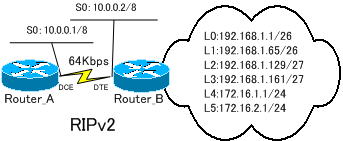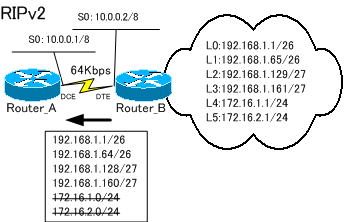ルートフィルタ設定(プレフィクスリスト)
ルートフィルタの設定を行います。ここでは、プレフィックスリストを使ってフィルタを作成し、インターフェイスの送信時にフィルタを仕掛けてみます。
まずは、フィルタを作成しないで下のRIPv2によるネットワークを構築します。

※ルート集約しないように「no auto-summary」コマンドを使用します。
各ルータのルーティングの設定は、以下のようになります。
●Router_A
Router_A(config)#router rip
Router_A(config-router)#version 2
Router_A(config-router)#network 10.0.0.0
Router_A(config-router)#no auto-summary
●Router_B
Router_B(config)#router rip
Router_B(config-router)#version 2
Router_B(config-router)#network 10.0.0.0
Router_B(config-router)#network 172.16.0.0
Router_B(config-router)#network 192.168.1.0
Router_B(config-router)#no auto-summary
●Router_Aの設定
!
version 12.3
service timestamps debug datetime msec
service timestamps log datetime msec
no service password-encryption
!
hostname Router_A
!
boot-start-marker
boot-end-marker
!
enable password cisco
!
no aaa new-model
ip subnet-zero
!
ip cef
!
interface FastEthernet0
no ip address
shutdown
speed auto
!
interface Serial0
ip address 10.0.0.1 255.0.0.0
clockrate 64000
no fair-queue
!
router rip
version 2
network 10.0.0.0
no auto-summary
!
ip classless
no ip http server
!
line con 0
line aux 0
line vty 0 4
password cisco
login
!
end
●Router_Bの設定
!
version 12.1
service timestamps debug uptime
service timestamps log uptime
no service password-encryption
!
hostname Router_B
!
enable password cisco
!
memory-size iomem 25
ip subnet-zero
!
interface Loopback0
ip address 192.168.1.1 255.255.255.192
!
interface Loopback1
ip address 192.168.1.65 255.255.255.192
!
interface Loopback2
ip address 192.168.1.129 255.255.255.224
!
interface Loopback3
ip address 192.168.1.161 255.255.255.224
!
interface Loopback4
ip address 172.16.1.1 255.255.255.0
!
interface Loopback5
ip address 172.16.2.1 255.255.255.0
!
interface Serial0
ip address 10.0.0.2 255.0.0.0
no fair-queue
!
interface Serial1
no ip address
shutdown
!
interface FastEthernet0
no ip address
shutdown
speed auto
!
router rip
version 2
network 10.0.0.0
network 172.16.0.0
network 192.168.1.0
no auto-summary
!
ip classless
no ip http server
!
line con 0
transport input none
line aux 0
line vty 0 4
password cisco
login
!
no scheduler allocate
end
Router_Aのルーティングテーブルを表示します。
●Router_Aのルーティングテーブル
Gateway of last resort is not set
172.16.0.0/24 is subnetted, 2 subnets
R 172.16.1.0 [120/1] via 10.1.12.2, 00:00:25, Serial0
R 172.16.2.0 [120/1] via 10.1.12.2, 00:00:25, Serial0
C 10.0.0.0/8 is directly connected, Serial0
192.168.1.0/24 is variably subnetted, 4 subnets, 2 masks
R 192.168.1.64/26 [120/1] via 10.1.12.2, 00:00:25, Serial0
R 192.168.1.0/26 [120/1] via 10.1.12.2, 00:00:25, Serial0
R 192.168.1.160/27 [120/1] via 10.1.12.2, 00:00:25, Serial0
R 192.168.1.128/27 [120/1] via 10.1.12.2, 00:00:26, Serial0
すべてのルートが表示されています。
フィルタの作成と適用
Router_Bから送信されるルート情報のうち、「192.168.1.」のルート情報だけ送信するようにします。そのために、Router_BのS0の送信時にフィルタを行います。
プリフィックスリストでは、サブネットマスクを指定することができます。送信したいルートは、192.168.1.1/26、192.168.1.65/26、192.168.1.129/27、192.168.1.161/27のルート情報です。
Router_Bでプリフィックスリストを作成して、S0の『OUT』にフィルタを配置します。

フィルタの作成
Router_B(config)#ip prefix-list FILTER permit 192.168.1.0/24 ge 25 le 27
サブネットマスクが、/25~/27のルート情報だけ、S0から送信するようにします。
フィルタの配置
フィルタの配置は、ルーティングプロセスで指定します。
Router_B(config)#router rip
Router_B(config-router)#distribute-list prefix FILTER out serial 0
Router_Bで、プリフィックスリストをS0の「OUT」に適用することで、Router_Bから送信される経路情報は、192.168.1.1/26、192.168.1.65/26、192.168.1.129/27、192.168.1.161/27の4つのルートになります。
Router_Aのルーティングテーブルを表示してみます。
●Router_Aのルーティングテーブル
Gateway of last resort is not set
C 10.0.0.0/8 is directly connected, Serial0
192.168.1.0/24 is variably subnetted, 4 subnets, 2 masks
R 192.168.1.64/26 [120/1] via 10.1.12.2, 00:00:22, Serial0
R 192.168.1.0/26 [120/1] via 10.1.12.2, 00:00:22, Serial0
R 192.168.1.160/27 [120/1] via 10.1.12.2, 00:00:22, Serial0
R 192.168.1.128/27 [120/1] via 10.1.12.2, 00:00:22, Serial0R 172.16.1.0 [120/1] via 10.1.12.2, 00:00:05, Serial0
R 172.16.2.0 [120/1] via 10.1.12.2, 00:00:05, Serial0
のルートを受信しなくなりました。これは、Router_B側でルート情報の送信時に、「172.16.1.0」「172.16.2.0」のルートをフィルタしたからです。
次は、ルートの再配送時に標準アクセスリストを使ってルートフィルタを検証してみます。続きは、「ルートフィルタ設定(ルート再配送時)」で紹介します。
